Common menu bar links
2005
Archived Content
Information identified as archived is provided for reference, research or recordkeeping purposes. It is not subject to the Government of Canada Web Standards and has not been altered or updated since it was archived. Please "contact us" to request a format other than those available.
Section 2: Knowledge of official languages (OLs)
Before studying the relationship between official languages and having an appropriate job, it is useful to examine immigrants’ level of official languages knowledge six months, two years and four years after their arrival.
In this study, we have chosen to use variables related to the ability to speak English and French, rather than those related to the ability to read or write in those two languages. Since these three variables are highly correlated, 1 it was felt that the ability to speak was a good indicator of the ability to function in a language.
Self-reported ability to speak the OLs
In the LSIC, immigrants were asked to assess how well they could speak each official language six months, two years and four years after their arrival. The possible answers were:
- cannot speak this language (level 1)
- poorly (level 2)
- fairly well (level 3)
- well (level 4)
- very well (level 5).
Immigrants whose mother tongue was English (the same applies to French) and whose language spoken most often at home in one of the three waves was also English (the same for French) did not have to answer this question. Since it was implicitly assumed that their level of spoken English (or French) was very good, they were assigned level 5. Accordingly, 22% of immigrants who ranked at level 5 in English in the first wave (as well as 18% in the second and third waves) had English as their mother tongue and spoke this language most often at home. For French, 25% of immigrants who ranked at level 5 in the first wave (and 23% and 21% for the following waves) had French as their mother tongue and spoke it most often at home.
These five levels are used throughout this study to determine the level of knowledge of English and French. It is true that these variables, since they are self-reported, may include response errors (some respondents may tend to overestimate or underestimate their abilities; others may assess themselves in comparison to family or friends; etc.). Therefore, care was taken in advance to validate these variables on the ability to speak English or French. The intention was to verify that the values reported were indeed consistent with those for other language variables included in the questionnaire, and this proved to be the case. Immigrants’ responses were also examined over time, and in general, they were consistent from one wave to the next.
An example of the validation performed with language data is shown in table 2.1 . Immigrants whose spoken level in a language was 2 (poorly), 3 (fairly well) or 4 (well) then had to answer five questions designed to determine the ease with which they managed to perform the following five tasks in that language: telling someone what they did before immigrating, giving their address, telling a doctor what the problem was, understanding a message over the telephone, and re-arranging a meeting. The response choices were "easily", "with some help", "with a lot of help" and "cannot do". If a score of 3, 2, 1 or 0 is assigned to each of these answers respectively and the scores for each of these questions are summed, an overall score is obtained for ease of functioning in the language. It is expected that an immigrant whose spoken level is 2 in a language will have more difficulty performing these five tasks and will therefore obtain a lower score than an immigrant whose spoken level is 3 or 4. The following table gives average scores by proficiency level for each language in the three waves.
As may be seen, immigrants whose spoken level in a language is higher do indeed find it easier to perform the five tasks measured, since the value of the score is higher.
This study also looked at immigrants’ socio-demographic characteristics according to their level of proficiency speaking English and French in Wave 1. Those characteristics are shown in appendix C .
| Proficiency level in English | Proficiency level in French | |||||
|---|---|---|---|---|---|---|
| 2 | 3 | 4 | 2 | 3 | 4 | |
| Wave 1 | 8.6 | 12.3 | 14 | 5.5 | 11.4 | 13.8 |
| Wave 2 | 8.4 | 12.5 | 14.1 | 5.7 | 11.3 | 13.9 |
| Wave 3 | 8.2 | 13 | 14.3 | 5.6 | 11.8 | 13.8 |
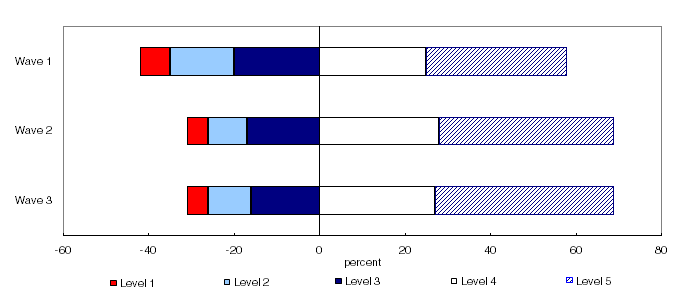
English and French spoken in Canada
Six months after their arrival, 58% of immigrants spoke English well or very well; very few did not speak it at all (7% in Wave 1 and even fewer in the following waves). During the first two years in Canada, there was an improvement in the self-reported level of spoken English, with a smaller improvement between the second and fourth years spent in Canada.
The knowledge of French in Canada as a whole was rarer. Eleven percent of immigrants reported speaking French well or very well six months after their arrival, while 14% reported comparable abilities four years after their arrival. By contrast, 76% of immigrants reported not speaking French at all six months after their arrival, and the percentage was still as high four years after their arrival.
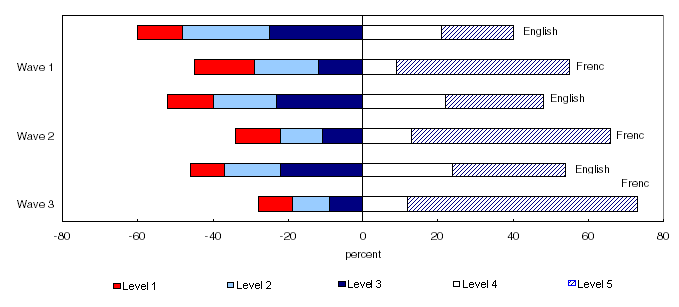
English and French spoken in Quebec
In Quebec, 55% of immigrants reported speaking French well or very well six months after their arrival, with this percentage climbing to 73% four years after their arrival.
As regards the level of English in Quebec, 40% of immigrants could speak this language well or very well six months after their arrival, with this percentage rising to 54% four years after arrival.
Immigrants’ ability to speak the two official languages (OLs)
Considering that an immigrant speaks English (or French) when he/she reports being able to speak that language well or very well, immigrants may be classified into four categories according to their ability to speak the two OLs: those who speak English only, those who speak French only, those who speak both English and French and those who speak neither English nor French. Charts 2.3 and 2.4 give an idea of the distribution of immigrants according to these four categories evaluated six months, two years and four years after their arrival, outside Quebec and in Quebec.
Outside Quebec, English-French bilingualism as well as French are almost non-existent, even four years after immigrants’ arrival in the country. However the percentage of immigrants speaking English only went from 60% at Wave 1 to 70% at Wave 3. After four years in the country, a little over one quarter of immigrants outside Quebec spoke neither English nor French.
In Quebec, English-French bilingualism (as defined here) almost doubled, reaching 36% at Wave 3 compared to 20% at Wave 1. As well, we note that the percentage of immigrants who could speak neither English nor French considerably decreased between Wave 1 (26%) and Wave 3 (9%).
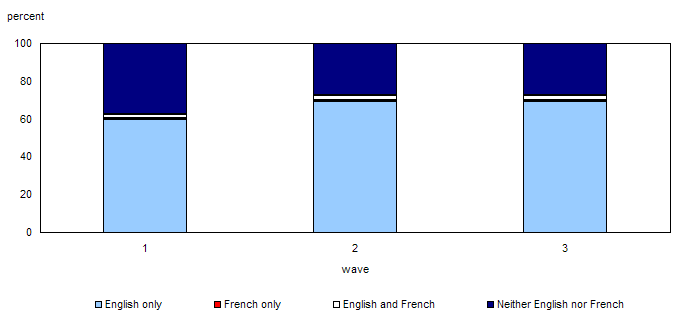
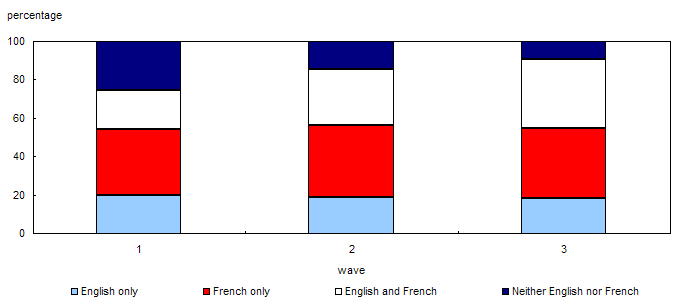
Importance of improving OLs in Canada
In each wave of the survey, immigrants who did not speak, read or write English (or French) very well 2 were asked whether it was important for them to learn or improve that language. The answer choices were "very important", "important", "not very important" or "not important at all".
In the first wave, 96% of immigrants who were asked the question for English answered that it was either very important or important to learn or improve their English. In the second and third waves, 96% and 93% respectively of immigrants who were asked the question said that it was very important or important to learn or improve their English.
Respondents’ opinion on this subject was fairly consistent over time, since 88% of immigrants who answered this question in the three waves said all three times that it was either important or very important to learn or improve their English.
As regards French in Canada, 37% of immigrants who were asked the question in the first wave felt that it was either important or very important for them to learn or improve their knowledge of that language. In the second and third waves, respectively 34% and 30% of immigrants felt the same. However, opinions regarding the importance of learning or improving one’s French were less consistent over time than for English. Fourteen percent of immigrants who had to answer this question in all three waves answered each time that it was important or very important for them to learn or improve their French, whereas 45% stated each time that it was not very important or not important at all.
Importance of improving OLs in Quebec
In Quebec, 88% of immigrants whose spoken, written and reading level in French was not at its maximum in the first wave said that it was important or very important to learn or improve that language. In the second and third waves, 92% and 89% respectively of immigrants who were asked the question said that it was very important or important to learn or improve their French.
As regards English in Quebec, 96% of immigrants said in the first wave that it was important or very important to learn or improve that language. In the second and third waves, respectively 95% and 88% of them stated that it was important or very important to learn English.
Among immigrants who had to answer this question in the three waves, 75% said consistently in all three waves that it was important or very important to learn or improve their French. As to English, 84% of immigrants consistently said that it was important or very important to learn or improve their English.
Among immigrants whose spoken, written and reading levels in both English and French were not at their maximum in a given wave in Quebec, a very large proportion said that learning or improving their knowledge of both the OLs was important or very important (with 86%, 87% and 82% respectively in the different waves). In other words, Quebec immigrants were very likely to say that learning both official languages was important or very important for them.
Language training
Some 45% of immigrants said they had taken language training in English since coming to Canada; 10% had done so in French.
In Quebec, 42% of immigrants had taken language training in French since their arrival, while 37% had done so in English. Sixteen percent of Quebec immigrants had taken language training in both official languages.
We tried to see whether immigrants who had taken language training in a given language were more likely to have made progress 3 in that language between Waves 1 and 3, compared to those who had not done so.
To make this comparison, we wanted to take account of the fact that some immigrants do not seek to improve their abilities in either of the official languages, while others cannot improve their abilities (on a scale of 1 to 5) since they are already at the maximum level in the first wave. Thus, to produce these results, two groups of immigrants were set aside. First to be excluded were immigrants whose level in the language was already at its maximum in the first wave (and who thus spoke very well), since those persons had mathematically no chance of being classified among the cases who had improved in the third wave. Next to be excluded were immigrants who could not speak the language at all in the third wave (that is, after having lived in Canada for four years), on the assumption that most of them were not necessarily trying to learn or improve that language. To better understand the reasoning behind these exclusions, it should be kept in mind that immigrants who spoke the language very well six months after their arrival were less inclined to take language training, as were those who had no desire to learn the language. Since both these groups were much less inclined to take language training, they falsely increase the impression that one cannot improve unless one takes language training.
The results for English show that the rate of improvement of the language is the same (55%) for immigrants who took language training as for those who did not. For French, the improvement rate for Canada as a whole is 74% for immigrants who took language training in that language, compared to 54% for those who did not. In Quebec, the improvement rate for immigrants who took language training in French is substantially the same (76%) as for those who did not (79%).
When the figures were examined more closely, it was found that among immigrants who made progress in English, those who had taken language training were more likely to have moved up more than one level (34%) than those who had not taken language training (26%). This difference is even more pronounced for French in Quebec: among immigrants who made progress in that language, 57% of those who had taken language training moved up more than one level, compared to 35% of those who had not taken language training.
From these results, it emerges that language training in English (in Canada) and language training in French (in Quebec), while enabling a large number of immigrants to improve their skills, are not the only way to improve one’s ability to speak the language. The mere fact of living in a region where a given language is spoken is conducive to improving one’s knowledge of that language. However, language training appears to be beneficial, since it enables a larger proportion of immigrants to make greater progress, compared to those who have not taken it.
For tables containing all these results for Canada and the provinces, see appendix D .
Benefits of language training
After four years in Canada, immigrants who had taken language training were asked whether it had been "very useful", "useful", "not very useful" or "not useful at all". 4 For English, 38% of immigrants stated that language training had been very useful to them, 47% considered it useful, 10% not very useful, 2% not useful at all and 3% said that it was too soon to answer, since the training had just begun.
In Quebec, 55% of immigrants who had taken language training in French stated that it had been very useful, while 35% considered it useful. For English, 41% of Quebec immigrants who had taken language training in that language felt that the training had been very useful, while another 42% found it useful.
The survey also sought to find out how language training had been useful to them in their daily life. Immigrants could give more than one answer to this question. Eight immigrants in 10 stated that language training in English had helped them in their daily communication. Nearly half (48%) said that such training had helped them to adjust to life in Canada. Making new friends (39%) and looking for or finding work (37%) were also reported by a large number of immigrants as being aspects that benefited from language training in English.
Very few immigrants stated that language training in English had helped them to gain recognition of their work experience (5%) or their credentials (4%).
In Quebec, language training taken in English and in French was considered useful for reasons similar to those given for Canada as a whole; the four aspects most often cited were exactly the same.
When comparing language training in English and French, there are few differences in the aspects reported as having helped immigrants. However, adjusting to life in Canada was reported more often by immigrants who took language training in French (51%) than those who took such training in English (38%). Similarly, making new friends was reported more often by immigrants who took language training in French (46%) than by those who took it in English (36%).
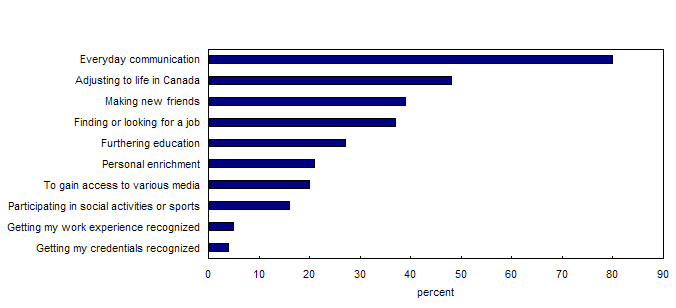
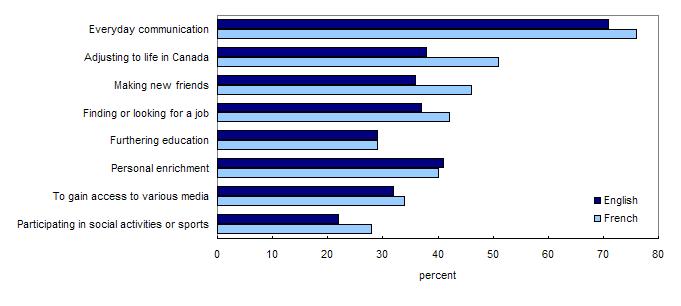
Means used to improve language skills
Language training is one way, but not the only way, to improve one’s language skills. Immigrants whose level in speaking, writing and reading was not already at its maximum at the time of the interview were asked what means they had used, other than language training, to improve their skills.
Eighty-two per cent of immigrants, who answered this question in at least one of the three waves, stated that they had improved their English owing to the different media (radio, movies, TV, newspapers, etc.). Ranking second were everyday interactions, mentioned by 63% of immigrants. A little over half of the immigrants (51%) said they had improved their English at work. Ranking third and fourth were self-study of English (46%) and learning from family and friends (45%). Lastly, 31% of immigrants stated that they had improved their English at school, while 17% improved it by taking other types of classes (other than language training).
The results are similar for Quebec. The means used by the greatest number of immigrants for improving their skills is using the media, with 84% of immigrants mentioning this means for English and 82% for French. Everyday interactions, friends and families, as well as school were mentioned more often as means of improving French (60%, 52% and 33% respectively) than means of improving English (44%, 31% and 23% respectively).


